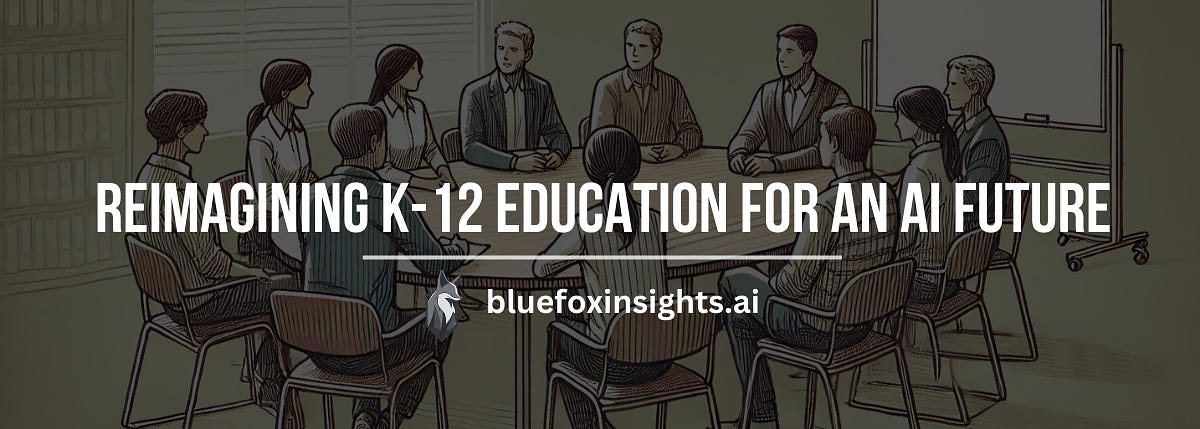Let's Create a Community to Reimagine K-12 Education in an AI-Enabled World
In a rapidly evolving world where artificial intelligence (AI) continues to evolve industries, education cannot be left behind. Today, educators, policymakers, and leaders are confronted with the challenge of integrating AI into the classroom in a way that enhances, rather than replaces, traditional learning methods.
The Future of K-12 Education: AI at the Helm
Early this morning, at the South Fayette Township School District’s Future Focused Learning Summit, I had the opportunity to speak about the transformative power of AI in K-12 education. My keynote, Coding the Future: Reimagining K-12 Education in an AI-Driven World, focused on the shifts in how coding and AI could reshape both the education system and the future workforce.
At the heart of this discussion is the growing role of AI in performing tasks traditionally reserved for humans, especially in technical roles like software engineering. As AI becomes more sophisticated, schools must reconsider how they teach skills like coding. This change is not just about modifying lesson plans—it’s about rethinking the entire structure of K-12 education to prepare students for a future where AI could theoretically do much of the work.
One of the most interesting questions considered during the summit was, “What will happen to the workforce when AI can perform complex tasks?” If AI begins to handle white-collar engineering tasks, how will education evolve to prepare students for this new reality? I explored this question by looking at both short-term impacts—how coding is likely to be taught differently—and the broader implications for future employment.
An Interesting Vision for Learning: Alpha School’s AI-Powered Model
During the summit, I referenced an interesting model from Alpha School in Austin, Texas, where students are embracing a new kind of education powered by AI. The school provides students with just two hours a day of traditional learning—math, science, reading, and writing—through AI tutors. There are no teachers. Instead, a suite of AI apps gamifies lessons, tracks student progress, and even monitors their attention using eye-tracking technology.
This model, as shown in a NBC TODAY Show clip from the school, represents a radical departure from traditional education. At Alpha, students not only excel academically—scoring in the 90th percentile on standardized tests—but also develop essential life skills. Their daily routines involve tasks like solving Rubik’s cubes, running a real Airbnb business, and even assembling IKEA furniture.
Yet, as potentially forward-thinking as this model is, it also raises some questions. First, Alpha School’s annual tuition of $40,000 makes it inaccessible to some students. Second, the school replaces teachers with guides—adults who oversee, but don’t teach. These guides are not experts in core subjects like physics or math, which presents another concern: is it enough to rely on AI to teach complex topics, or do students still need human expertise?
The Role of AI and Human Teachers
As Alpha School exemplifies, AI can personalize education in ways that traditional methods cannot. By adjusting lessons to suit individual student needs, AI has the potential to dramatically increase learning efficiency. However, we must also address the limitations of AI.
AI tutors, no matter how advanced, cannot replicate the emotional intelligence and subject-matter expertise that human teachers bring to the classroom. AI systems are prone to hallucinations and inaccuracies and generative AI could inhibit learning if students rely too heavily on it. These issues underscore the importance of maintaining a human element in education, particularly when dealing with subjects that require deeper understanding and nuanced teaching.
As I stated during my keynote, “AI can help guide students, but we still need experts in physics, english, and other critical areas.” It’s not a matter of choosing between AI and teachers, but about finding the right balance where AI enhances the teaching experience without completely replacing the invaluable human touch.
Building an AI Education Community
Following my keynote, many educators asked how they could access more insights on integrating AI into their curriculums. I mentioned that over the past two years, I’ve been asked to speak at various Pittsburgh school districts about how AI is reshaping education. I love doing these talks, but with my work and travels, it’s hard to accept all the invitations. At one point, I decided to start charging for these appearances as a way to manage the demand. But honestly, it didn’t sit well with me—schools with tighter budgets couldn’t bring me in, and that wasn’t what I wanted.
Now, I’m thinking of a different approach: live webinars. Instead of traveling from district to district, I could offer these talks online for free, allowing educators from all over to join in. I threw out the idea of using bluefoxinsights.ai as a platform to create an online community where educators can share ideas and collaborate on AI-driven education strategies. This could create a space for ongoing discussions, where we could brainstorm ideas on how to integrate AI into K-12 education. It’s a way to share knowledge without limiting access, and I’m excited to see how this could grow into a community of forward-thinking educators.
A Call to Action
As AI continues to evolve, so too must our approach to education. I encourage educators, parents, and policymakers to join the conversation. We must ask ourselves tough questions: How can we ensure AI supports learning without overshadowing the importance of human expertise? How do we make these innovations accessible to all students, regardless of their socioeconomic status?
🎆🎆🎆 If you are interested in continuing this discussion or joining an AI-focused educational community, I invite you to leave comments on this article with your thoughts. 🎆🎆🎆 I do not think this has to be limited to Pennsylvania, but maybe that’s the easiest way to start since I’ve met so many of you. Together, maybe we can use this community to shape the future of K-12 education in a way that prepares students not just to survive in an AI-enabled world, but to thrive in it.




